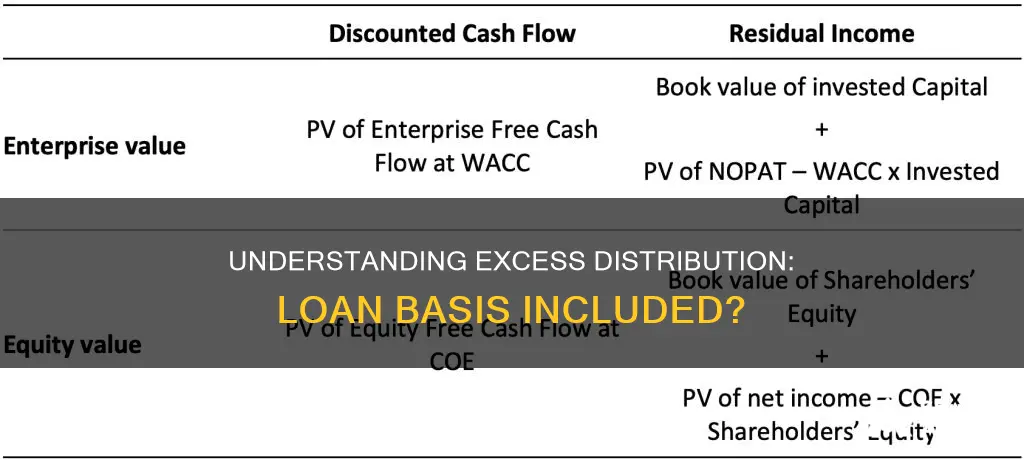
Excess distributions and shareholder loan repayments can have significant tax implications for S-Corporations and their shareholders. Shareholder basis in an S-Corp is influenced by capital contributions, loans, and company income, while losses and shareholder repayments reduce the basis. Shareholders can only take losses if they have a basis in the company. When distributions exceed the shareholder basis, it results in an unnecessary capital gains tax liability. Understanding the basis situation before the year-end is crucial for planning and avoiding excess distribution issues. Shareholder loans are generally considered debt basis, and they impact tax calculations differently from distributions.
What You'll Learn

Shareholder loan repayments
When a shareholder provides a loan to the business, it increases the shareholder's basis in the company. This basis is then reduced by losses and money paid back to the shareholder. Shareholders can take on losses as long as they have a basis in the company. It is important to note that only money personally loaned or contributed to the company by the shareholder counts towards the basis. Loan guarantees or similar arrangements do not provide a basis for the shareholder.
In the case of an S corporation, shareholder loan repayments can have specific tax consequences. When an S corporation repays a loan to a shareholder, it reduces the shareholder's basis in the loan. If the loan repayment exceeds the shareholder's basis in the debt, it becomes a taxable event for the shareholder. This gain on the repayment of the reduced-basis debt does not increase the debt basis for utilizing the S corporation's losses.
To minimize the tax effects of shareholder loan repayments, it is crucial to properly document and structure the loan. Shareholder loans should be treated as arms-length" transactions, with separate entities and terms comparable to market rates. A written loan agreement should outline the exact loan amount, interest rate, and repayment terms. Additionally, an amortization table should be created to detail the principal and interest components of each repayment.
Planning ahead is essential to avoid excess distributions and gains on shareholder loan repayments. Understanding your basis situation before the end of the year can help you make informed decisions about moving money to minimize tax obligations. Consulting with an accountant or tax professional is advisable to navigate the complexities of shareholder loan repayments and their tax implications effectively.
MPN Student Loans: Who Needs to Fill Them Out?
You may want to see also

Shareholder basis
When an individual becomes a shareholder in an S corporation, their focus is often on the business's operations and success. However, it is equally important to grasp the concept of shareholder basis, which represents their investment in the company. This basis can be in the form of capital contributions, loans made to the company, and company earnings.
To calculate shareholder basis, one can use Form 7203, S Corporation Shareholder Stock and Debt Basis Limitations. This form helps determine the shareholder's initial capital contribution or the cost of the stock they purchased. Subsequently, this amount is adjusted based on pass-through amounts from the S corporation, including income, losses, and deductions. It's important to note that shareholder basis is the responsibility of the shareholder to track, not the corporation.
Understanding shareholder basis is crucial for tax planning. When a shareholder receives a distribution, they must determine whether it is taxable or not. If a distribution exceeds the shareholder's basis, it is taxed as a capital gain. Shareholders can face significant tax consequences if they do not carefully consider their basis when planning withdrawals or distributions from the company.
Loans and Financial Intermediaries: An Inevitable Partnership?
You may want to see also

Capital gains
A capital gain is the profit or increase in the value of a capital asset, which is realized when the asset is sold. Capital gains are taxed under certain circumstances. The rate of tax depends on the type of capital gain, i.e., short-term or long-term, and the individual's taxable income and filing status.
Short-term capital gains refer to assets held for a year or less, and are taxed as ordinary income. Long-term capital gains refer to assets held for more than a year and are usually taxed at a lower rate than ordinary income tax rates.
In the context of excess distributions and shareholder loan repayments, capital gains can occur when a shareholder takes out more money from the company than they put in. This can be in the form of loans, such as EIDL loans or PPP money, which are not considered income and are therefore taxed as capital gains when distributed. Shareholders can plan ahead to reduce or avoid these gains by considering the timing of their note payments and utilizing tax planning strategies.
For S-Corporations, a non-dividend distribution in excess of stock basis is taxed as a capital gain on the shareholder's personal return. If the S corporation stock has been held for longer than a year, it is considered a long-term capital gain. Shareholder basis in an S-Corp can be increased by capital contributions, loans, and company income, while it is reduced by losses and money repaid to the shareholder.
Additionally, when a creditor sells collateral to secure payment of a debt, it triggers capital gains taxation for the debtor. This can be advantageous in certain situations, such as when there is a step-up in basis due to the death of the owner, as the collateral is treated as if it was purchased at fair market value on the date of death, effectively reducing capital gains taxes.
The Journey's Loan: A Universal Experience?
You may want to see also

Tax consequences
When it comes to the tax consequences of excess distributions, there are a few key points to consider. Firstly, shareholders of S Corporations must be mindful of taking distributions in excess of their stock and debt basis. This stock basis is calculated based on the initial capital contribution to the S Corporation or the initial cost of the purchased stock, and it changes every year, so it must be computed annually.
If a shareholder takes distributions exceeding their stock basis, these excess distributions are typically taxed as capital gains on the shareholder's personal return. The tax rate for long-term capital gains is currently 15% or 20%, depending on the individual's tax bracket. Shareholders should be cautious about borrowing money to fund losses or personal distributions, as this can lead to negative tax consequences. Bank loans, even if personally guaranteed, do not provide shareholders with a basis unless the loan is made personally to the shareholder, who then loans it to the S-Corp.
In the context of partnerships, a partner's basis represents their investment, initially calculated based on the cash and fair market value of the property contributed. When distributions surpass the partner's basis, the excess is treated as a capital gain, typically classified as a gain from the sale or exchange of the partnership interest. The timing and type of distributions matter; current distributions reduce the basis but do not result in immediate taxes unless they exceed it, while liquidating distributions upon the partnership's dissolution may lead to a gain or loss depending on the remaining basis.
Additionally, the concept of "excess distributions" is relevant when calculating taxes for foreign mutual funds. In this context, excess distributions occur when the distributions in the current year exceed 125% of the average of the previous three years (or less than three years, depending on the investment duration). When calculating taxes, the portion of the distribution considered an excess distribution is taxed at the highest available tax rate under the tax code.
Explore Loan Recast Options: Not All Lenders Are Equal
You may want to see also

Debt basis
Shareholder basis in an S-Corp increases when shareholders put money into the company through capital contributions and loans, as well as any income the company earns. Conversely, shareholder basis is reduced by losses and money paid back to the shareholder. Shareholders can take losses as long as they have basis in the company.
When determining the taxability of a non-dividend distribution, the shareholder considers only their stock basis, not their debt basis. However, for loss and deduction items that exceed a shareholder's stock basis, the shareholder is allowed to deduct the excess up to their basis in loans personally made to the S corporation.
If a shareholder has S corporation loss and deduction items in excess of their stock basis and those losses and deductions are claimed based on debt basis, the debt basis of the shareholder will be reduced by the claimed losses and deductions.
To calculate shareholder stock and debt basis, Form 7203, S Corporation Shareholder Stock and Debt Basis Limitations, may be used. Shareholders start with their initial capital contribution to the S corporation or the initial cost of the stock they purchased, then increase or decrease this amount based on the pass-through amounts from the S corporation.
Frequently asked questions
An excess distribution occurs when a partner or shareholder takes more money out of the company than they put in.
You can either not take the cash out in the form of a shareholder distribution, or you can use another depreciation method that spreads the deduction across several tax years.
Excess distributions are taxed as capital gains (generally long-term) on the shareholder's personal return.
Basis includes income gains and losses allocated based on ownership percentage, as well as any contributions made to the business.







